
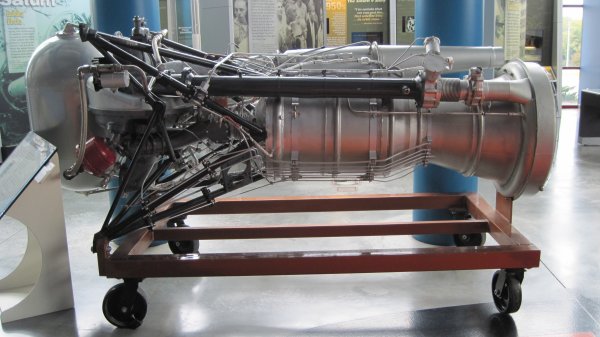
The Redstone Engine
Compiled by Kimble D. McCutcheon
Unless Noted Otherwise, Photographs by Kimble D. McCutcheon
 |
 |
| The North American Aviation XLR-43-NA-1 (NASA) | The Rocketdyne 75-110-A7 |
After a period of examining and experimenting with captured V-2 rockets, US engineers, sometimes in conjunction with the German engineers and scientists who had immigrated to the US, began working on designs of their own. North American Aviation developed the XLR-43-NA-1, a LOX/alcohol engine based on V-2 technology for its Navaho cruise missile project. This engine had half the mass and 34% more thrust (75,000 lb) than the V-2 engine. The complex and costly V-2 combustion chamber, with its 18 thrust chambers, spherical shape, and LOX plumbing maze, was replaced by a flat plate injector and conical combustion chamber. A straight-sided 15° divergent nozzle section was retained. Similar to earlier V-2s, the XLR-43-NA-1 had a turbopump driven by high-pressure steam generated by catalyzing hydrogen peroxide with potassium permanganate pellets in the steam generator. This engine was the ancestor of all future North American Aviation (later Rocketdyne) engines. Thrust chamber and nozzle film cooling was achieved by fuel jets from the injector instead of the more complex rings of holes used on the V-2 engine.
Initially, this new single thrust chamber, with its flat plate injector, exhibited combustion instability, the same problem that had led to the V-2's complexity. But Rocketdyne engineers persevered and solved the problem, gaining experience that would be of great use in the future.
When the Redstone development team, led by V-2 rocket scientist Wernher von Braun, needed an engine capable of 75,000 lbT, Rocketdyne was asked to modify the XLR-43-NA-1 to meet the new requirements. The new engine was designated NAA 75-110, and the first one was ready for shipment to Redstone Arsenal by the end of July 1953.
The A6 and A7 variants became Redstone missile production engines.
The A6 burned LOX and alcohol to produce 82,595 lbT at sea level and 93,138 lbT in a vacuum. It had a chamber pressure of 318 psia, a sea level specific impulse of 235 sec, a vacuum specific impulse of 265 sec, and a burn time of 155 sec. Thrust to weight ratio was 64.2:1.
The A7 burned LOX and alcohol to produce 78,000 lbT at sea level and 89,000 lbT in a vacuum. It had a chamber pressure of 318 psia, a sea level specific impulse of 235 sec, a vacuum specific impulse of 265 sec, and a burn time of 155 sec. Thrust to weight ratio was 64.2:1.
Redstone Engine Components and Functionality
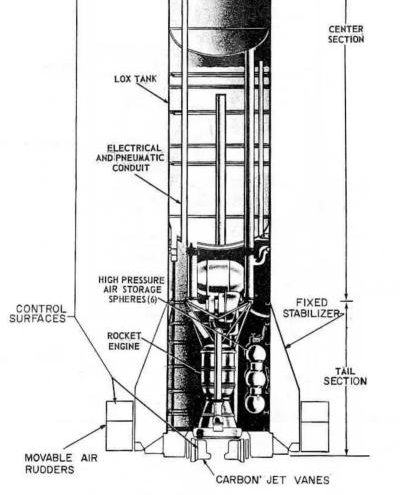 |
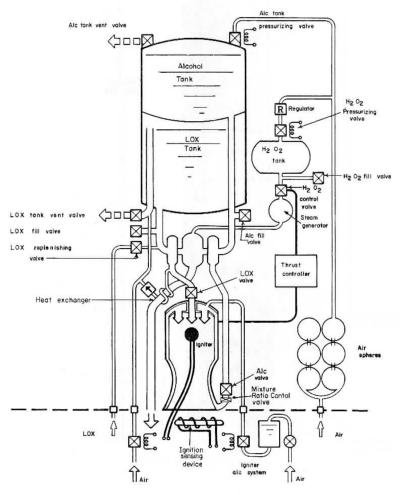 |
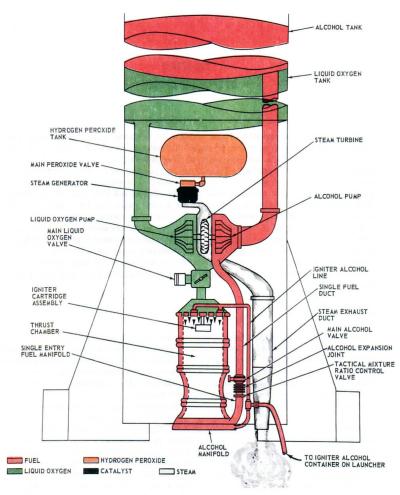 |
| Redstone Thrust Unit (US Army) | Redstone Propulsion System Functional Schematic (US Army) | Redstone Propellent and Hydrogen Peroxide Flow (US Army) |
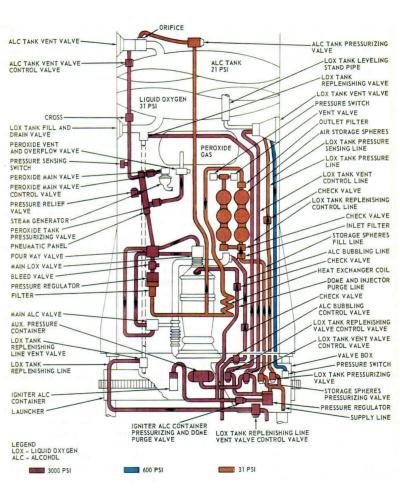 |
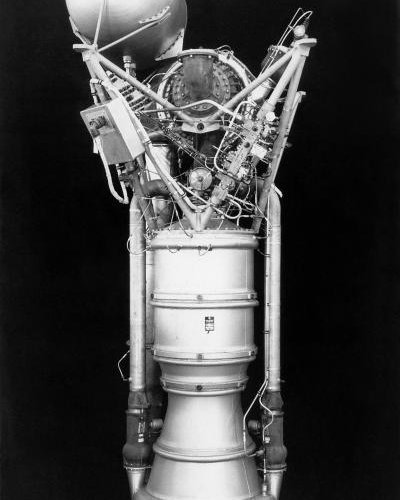 |
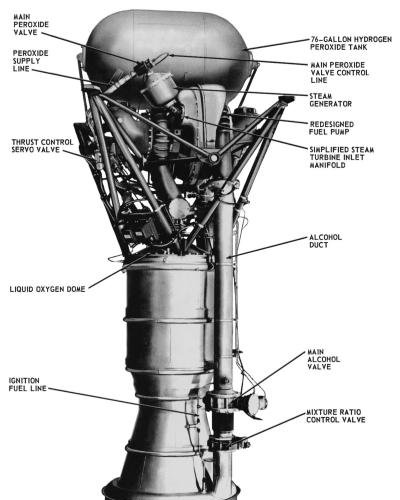 |
| Redstone Pneumatic System (US Army) | The NAA (Rocketdyne) 75-110-A6 has two fuel supply lines. (heriocrelics.org) |
The NAA (Rocketdyne) 75-110-A6 has one fuel supply lines. (heriocrelics.org) |
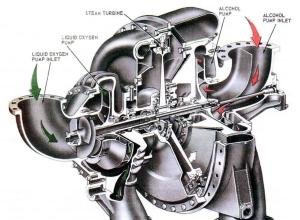 |
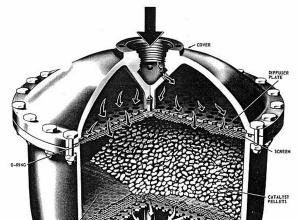 |
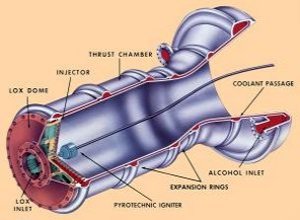 |
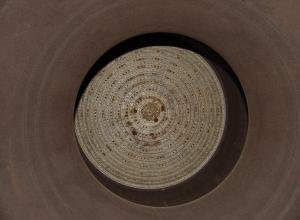 |
| NAA (Rocketdyne) 75-110-A7 Turbopump (US Army) | NAA (Rocketdyne) 75-110-A7 Steam Generator (US Army) |
NAA (Rocketdyne) 75-110-A6 Thrust Chamber (heriocrelics.org) |
NAA (Rocketdyne) 75-110 Flat Plate Injector (heriocrelics.org) |
Component Details
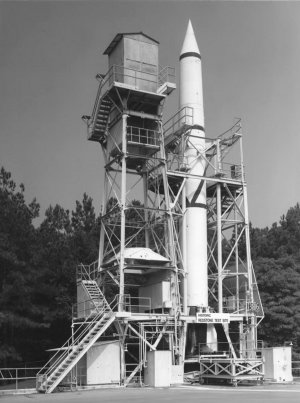 |
| The Interim Test Stand (Wiki) |
The Interim Test Stand
In the autumn of 1952, when it came time to assemble and test the Redstone, a test stand was needed. The Army was flush with research and development funds, but was prohibited from spending any R&D money on facilities. Getting facilities money would require a two-year Congressional funding cycle. With a $25,000 spending limit, engineers scoured Redstone Arsenal for scrap material from which they could build an "interim" test stand. Rough sketches drawn on scrap paper replaced blueprints. Welders constructed a small structure that was anchored to a reinforced-concrete foundation that had had consumed most of the $25,000. With no money for control equipment and recording instrumentation bunkers, two abandoned railroad tank cars were cleaned, outfitted, and buried under earth mounds about 100 yards from the test stand. This "interim" test stand not only got the Redstone missile flying, but was used well into the 1960s for engine testing on other projects, such as the Jupiter engine and man-rating the Mercury-Redstone rocket.
Redstone Firing Procedure
After the missile has been erected, tested, and optically aligned to the True Line of Fire (TLOF, that line over the ground that connects the missile launcher to the target), the final firing preparations are begun. Some of the fueling preparations can be started as soon as the missile has been erected. This activity would include the connection of the various alcohol and LOX lines and valves and the positioning of the fueling ladder. The fire-fighting equipment should be in the area during propellant loading operations. The engine jacket is filled with lithium chloride from a container on the alcohol trailer; this permits a smooth transitional flow of alcohol during engine start.
Alcohol Filling is started after vertical simulated flight testing has been performed.
The alcohol trailer is positioned approximately 20 feet from the fueling ladder. The igniter alcohol container, located in the launcher, is filed by gravity flow from the alcohol trailer emergency valve. The alcohol trailer is connected, through the fueling ladder, to the missile alcohol tank, and the alcohol is pumped into the tank. When the missile alcohol tank is full, the alcohol trailer is disconnected and driven out of the immediate launch area.
LOX Filling is accomplished from two LOX trailers that are simultaneously connected, through a "Y" connection, to the fueling ladder and then to the missile LOX tank. LOX pumping is started from one of the LOX trailers. After a delay of three or four minutes, the pumping of the second LOX trailer (replenishing trailer) is started. This delay is to assure that the depletion of LOX in the second trailer will be less than that of the first, after LOX filling is completed. When the missile LOX tank is full, the LOX pumping operation is stopped and the first LOX trailer is disconnected and driven out of the immediate launching area. The second LOX trailer (the replenishing trailer) is disconnected and moved away from the launcher to a distance of approximately 150 feet. A LOX replenishing line is then connected from the replenishing trailer to the replenishing arm, mounted on the launcher and connected to the missile LOX tank. Periodically, throughout the rest of the operation until missile firing, the normal LOX boiloff from the missile LOX tank will be replaced by the operator of the remote firing box via a replenishing switch.
A hydrogen peroxide truck is positioned near the missile, and the container is connected to the missile hydrogen peroxide tank. The hydrogen peroxide is then pumped into the missile tank. Upon completion of the hydrogen peroxide filling, the hydrogen peroxide truck is disconnected and driven from the immediate area.
Final check vertical range computer is performed, along with operational status checks of the range guidance computer and the cutoff computer. Upon verification of the in-tolerance operation of the range computer, the presetting information listed on the firing mission data sheet is installed into the cutoff computer. This presetting information includes constant values of velocity and displacement, which are compensation for inherent errors peculiar to the individual trajectory of the missile.
A final check of the vertical lateral computer is performed, followed by a warhead prelaunch check, which verifies network circuits related to the warhead. The type of warhead burst (air or surface) is also selected at this time.
The guided missile test station is disconnected from the missile system and driven out of the firing area. The powerplant ignition system is readied and the blind plugs, which serve as deactivating or safety devices, are installed. A final check of the missile TLOF is conducted. The immediate firing area is cleared of extraneous equipment and personnel.
The remote firing box operator operates the LOX replenishing switch until LOX tank overflow is visible. At the predetermined time and on order from the Firing Battery Commander, the remote firing box operator closes the firing switch.
Once the firing command is given, the general missile system operating sequence is as follows:
1.) Missile propellant system vent valves, which were opened for propellant filling, are closed.
2.) The missile pneumatic system is then utilized to pressurize the propellant tanks. The pressurization of the hydrogen peroxide and alcohol tanks is started immediately upon the firing command signal. When the alcohol tank pressure is sufficient, alcohol tank pressurization stops and LOX tank pressurization starts. Throughout a portion of the flight, propulsion system tanks pressurization cycles because of pressure-sensing switch action.
3.) When LOX tank pressure has reached a specific amount, a pressure switch is actuated to stop the LOX tank pressurization and to start the power transfer sequence. The missile system has been operating from ground power until this time in order to save the missile batteries, which are very short-lived under normal loading conditions. During the power transfer sequence, the missile batteries are connected to their respective missile busses, in parallel operation with the ground power sources. When the tie-in has been accomplished, the ground power sources are disconnected from the missile system. The operation results in a smooth transition from ground power to missile battery power.
4.) Completion of the power transfer sequence initiates action to propel the heater-cooler drop tank away from the missile.
5.) The physical breaking of the electrical connections between the missile and the heater-cooler drop tank actuates the ignition starting sequence. After a slight time delay, which allows the three missile batteries to settle down under the rather rapid loading action of the power transfer sequence, the igniter squib is fired and ignition takes place. LOX, in the ignition stage, is taken directly from the missile LOX tank under gravity flow while the alcohol is obtained under pressure from the igniter alcohol container located on the launcher.
6.) The mainstage stick link is physically located so as to be burned through by the heat of combustion within the engine. This results in the opening of the main alcohol and the hydrogen peroxide flow valves in anticipation of thrust buildup. The hydrogen peroxide flows onto the catalytic pellets in the steam generator and causes a steam buildup which drives the turbopump, which, in turn, drives missile alcohol and LOX into the combustion chamber, where the mixture is burned to produce thrust.
7.) When the engine thrust has developed to the point of overcoming the force of gravity, the missile rises from the launcher. At this point, the flight phases are started and the missile guidance and control system is activated.
8.) The program device is actuated to begin triggering certain critical electrical circuitry.
9.) The stabilized platform in the guidance system loses its earth-fixed reference and becomes inertially stabilized in space. Any attitude deviation of the missile from the prescribed trajectory is detected and corrected by the control system.
10.) The guidance computers are activated to detect and store any translational deviations of the missile from the desired trajectory.
11.) The cutoff computer is started and monitors the speed of the missile. When the missile reaches a predetermined velocity, this computer will shut down the propulsion system by cutting off the propellant flow to the engine. The missile will then be in the ballistic, or free-falling, phase of its flight.
12.) The propulsion system shutdown is followed by thrust decay, or burnout of the propellants remaining in the propulsion system downstream of the main propellant valves.
13.) At a predetermined time, the pulse step switch actuates the separation circuitry, which blows explosive bolts attaching the missile thrust unit to the body section.
14.) When the body section comes back into the sensible atmosphere, a "Q" switch is actuated. This is the start of the re-entry phase and the end of the ballistic part of the missile flight. The actuation of the "Q" switch also signals the start of the terminal guidance operation. During the flight, the guidance computers had detected and stored the translational deviations of the missile from the prescribed trajectory. After re-entry, this information is fed to control system in order to direct the missile back toward the prescribed trajectory to assure that the warhead will land within the radial tolerance distance of the target.
Redstone Firsts
In addition, experience gained in developing Redstone helped pave the way for visiting the moon.